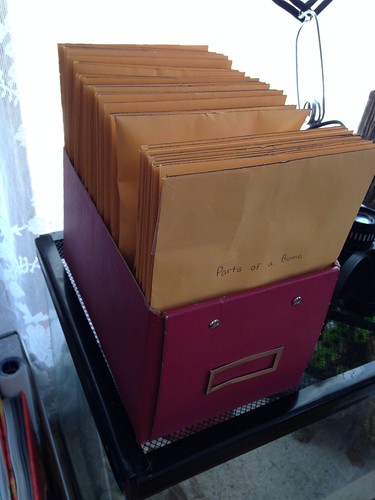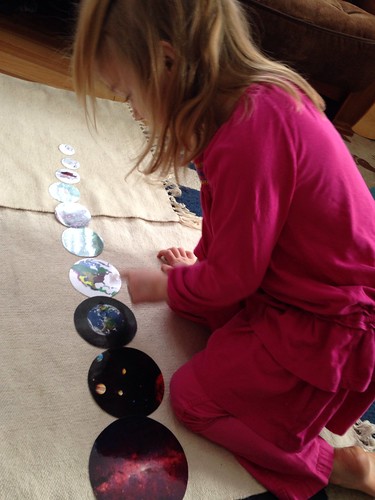This weekend I went through the Waseca Elementary Intro to Biomes material and organized it in relationship to all of the rest of my card work in botany, zoology, and earth science. Considering plants, for example, after the Parts of a Flowering Plant included in Waseca, I filed (and by filed, I mean lined up in envelopes in a shoe box) all of our plant identification, tree identification, flower identification, seeds/plants matching, plant life cycles etc.
It won’t be quite as simple as a matter of sequence since some of the card work is for more advanced students and some of it is more introductory. Considering birds, for example, I have a set of cards that is simply matching the birds to the silhouette that is appropriate for my youngest students and a set that includes beak adaptations that has a fairly high reading level. Now when we are studying a specific component of the biomes, I can quickly pull out and present the card work that is appropriate for each student. Previously I had the card works spread out all over my school room based on a balance of age and subject which was not efficient for me to find anything (not to mention the curriculum isn’t that delineated in the first place).
This weekend I also made us our own biosphere tower. I thought I had a set of nesting blocks I could use, but I was missing some of the cups so I decided to improvise instead of spend money. Now we have a two- dimensional version instead. Not quite as neat, but my kids seem to really like it. I’ve been impressed with how quickly Kylee especially has picked up on the specific terminologies.
I decided to use the tower as a way to also do a very basic introduction to the bottom levels with the younger two, so I filed my planets/space card work towards the front.
Logan is just reaching the point where he can match the words section of 3 part cards. He’s been matching the pictures for a while, but especially when it comes to longer words it can be a bit tricky to visually discriminate.
I had never heard of this company until MBT mentioned them maybe 6 months ago. Since then I have poured over the website and the materials trying to figure out the best and most efficient way to transition from the approach we have been taking towards geography up to this point. I think the thing that hooked me is that this is a more logical path through the geography chart materials, with more focused and interesting topics of study. We have also never gotten hugely into the political geography, especially of Eastern Hemisphere continents, simply because of the fluidity of the regions but I want the kids to still have an understanding of the cultural and topographical geography (which Waseca will allow for). We will obviously still study political geography, but I think it will be primarily at the elementary level and restricted to own country, own continent, and major countries of the other continents.
With the weather warming this week, I was able to send the kids out into our creek bank (dry in the summer, but started running like crazy yesterday) and they collected all the parts of the biome and came back sopping wet and content. While the rugs in my back entry may not ever dry from all the water they brought with them, I can see they also brought back some great understanding and connections.
I’m always on the lookout for ways to use one path for all of the kids and I really think I’ve found it here. As we continue through, some topics will not be understood by Logan and Aidan will undoubtedly do research that goes above and beyond what Kylee is able to complete. Using it as a cycle, however, will allow for a gradual development of advanced understandings. Having all of my card work organized according to their model should hopefully only help that!
(And in a completely selfish note, switching approaches should cut down on the number of geography charts I still need to make since this will replace some and eliminate others!)






Looks great 🙂
I will send people here when they ask why we use the Waseca to direct our geography/botany/zoology instead of just the albums. You put it into words better than I could.
I just got the North America "curriculum" book in the mail yesterday. Haven't opened the box yet. For some reason NA has an album and none of the other continents seem to. I'll figure out what's in there and let you know 🙂
Thanks! I haven't decided what to do with the continents part yet. Partially because earlier this year I took a "Tour the Continents" curriculum and hacked it into pieces to make picture cards of animals, people, culture, landforms, landmarks, etc. of each continent so I already have all of those even if they aren't all that fancy.